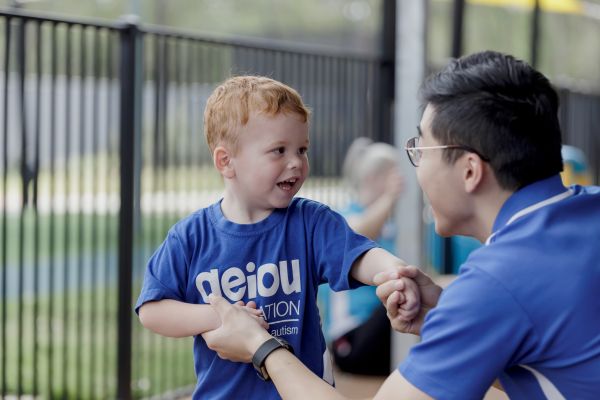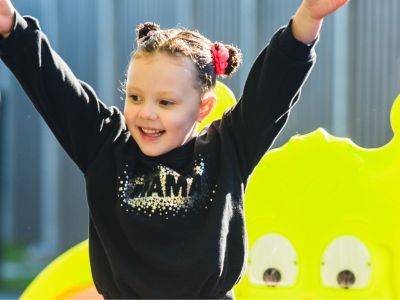
A blog by Samuel Tsai, Program Coordinator secondment (Senior Occupational Therapist), AEIOU Foundation
Ever wondered what an Occupational Therapist actually does? There are so many times I’ve been asked if my job involves helping people find their true calling in a career occupation. So you can imagine that it brings me great joy when I meet someone who tells me ‘I know exactly what you do’.
Over the past week, my fellow OTs and I have been celebrating World Occupational Therapy Week, and I wanted to share a glimpse into my life as an OT and what that means... It may not be what you expect.
Let’s clear one thing up first: in Occupational Therapy, “occupation” refers to the everyday activities that people need to, want to or are expected to be capable of completing. For children, these activities centre around play and learning, including engaging with toys, tying their shoelaces and fostering independence. This is OT, and this is how an OT contributes to a child’s development at AEIOU.
There are four main facets of the early intervention service at AEIOU which are driven by our occupational therapists:
- Play skills (so a child is able to occupy their time through play with toys);
- Social skills (so a child is able to engage with their friends or has an awareness of their surroundings for the early learners);
- Self-help skills (so a child is able to complete daily tasks independently, e.g. dressing, toileting and mealtimes); and
- Fine and gross motor skills (so a child has the ability to engage in outdoor activities and can hold a pencil with a functional grasp).
In my role as an OT, I work together with my transdisciplinary team to create opportunities to practice and develop these essential skills during the intensive program time. Transdisciplinary means that as a team of professionals, we work together to evaluate, implement and assess the supports we provide to children.
- At AEIOU, after the families drop their children to the centre, we begin the day’s program in the rooms with Morning Circle Time. This is where we practice our attending skills and social skills. I work with the Room Leader to engage the children’s attention—and keep them engaged!—in a warm welcome to the day ahead. We practice waiting our turn to greet another child in the group, and practice our social skills by saying hello to our friends.
- At morning tea or lunch, I work with the children to collect and open their lunchbox, to eat their lunch, and to pack it away. For many of our families, developing independence during mealtimes is a key goal. This might involve me sitting with a child and teaching them the steps involved to feed themselves a pot of yoghurt: using a spoon, lifting it to your mouth.
- My time spent in our learning centres is heavily focused on developing the children’s play skills. Some of our children are uninterested in playing when they initially start at AEIOU, but it is my job to find ways to make their play fun and meaningful for them—this is all about the children occupying their time in a functional way. Play is an important part of our program as it facilitates the development of other skills such as requesting, problem solving, concepts and motor skills.
- When it’s time for outside play, we like to work up a sweat! Admittedly, this is one of my favourite parts of the day, and you’ll see me running around playing chase with the children, jumping on the trampoline or making sandcastles in the sandpit. As always with play, it’s important for us to follow the child’s lead when expanding their interests and we encourage a child to engage in activities for an appropriate duration of time. During outside play, my role as an OT also sees me working with the children to keep their hats, shoes and socks on for the session.
- When it’s time for a nappy change, I’m working with a child to develop their independence in pulling their pants up and down, sitting on the toilet (for an appropriate duration of time) and washing their hands thoroughly with soap. For children who aren’t yet toilet trained, participation in the toileting routine is an essential first step.
- Social group is a crowd favourite among the children and staff. The children usually have way too much fun to realise they are actually learning! When it’s my turn to run the social group, I focus on thinking up fun and novel ways to teach new and consolidate existing skills. Each social group is tailored to target a specific skill: for example, we will play ‘Duck, Duck, Goose’ to practise playing group games and ‘Musical Chairs’ to work on tolerating the sense of losing in play. We will practise waiting our turn to ‘Pin the Tail on the Donkey’. During social groups, OTs may work alongside speech pathologists to develop conversational skills by answering social questions such as “What is your favourite colour?”
So, what is OT when it looks so different throughout the day and across each activity? At AEIOU, while every day is a new challenge, in everything that we do, OTs all work with the children towards one overarching goal: supporting the development of the everyday skills they need to be able to interact with the world around them. Day-to-day, an OT’s work comes in the form of teaching children to tie their shoelaces or how to hold their pencil, but an OT’s deeper work is to encourage a child’s love of play, share skills to engage in social situations, and foster their self-help skills and independence.
Every day, I get to work with these little people to help them access and interact with the world they live in. This is what OT really is, and it’s the reason why I come to my job at AEIOU each day with a spring in my step.


































